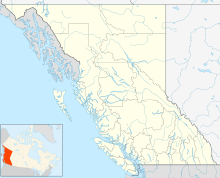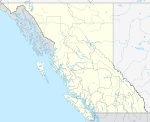
Fort St. John is a city located in northeastern British Columbia, Canada. The most populous municipality in the Peace River Regional District, the city encompasses a total area of about 22 square kilometres (8.5 sq mi) with 20,155 residents recorded in the 2016 Census. Located at Mile 47 of the Alaska Highway, it is one of the largest cities between Dawson Creek, British Columbia and Delta Junction, Alaska. Established in 1794 as a trading post, Fort St. John is the oldest European-established settlement in present-day British Columbia. The city is served by the Fort St. John Airport. The municipal slogan is Fort St. John: The Energetic City.

Dawson Creek is a city in northeastern British Columbia, Canada. The municipality of 24.37 square kilometres (9.41 sq mi) had a population of 12,978 in 2016. Dawson Creek derives its name from the creek of the same name that runs through the community. The creek was named after George Mercer Dawson by a member of his land survey team when they passed through the area in August 1879. Once a small farming community, Dawson Creek became a regional centre after the western terminus of the Northern Alberta Railways was extended there in 1932. The community grew rapidly in 1942 as the US Army used the rail terminus as a transshipment point during construction of the Alaska Highway. In the 1950s, the city was connected to the interior of British Columbia via a highway and a railway through the Rocky Mountains. Since the 1960s, growth has slowed, but the area population has increased.

Peace River South is a provincial electoral district for the Legislative Assembly of British Columbia, Canada. It was created under the name South Peace River by the Constitution Amendment Act, 1955, which split the old riding of Peace River into northern and southern portions for the 1956 BC election. Its current name has been in use since 1991.

The District of Taylor is a district municipality in northeastern British Columbia, Canada, located on mile 36 of the Alaska Highway. Taylor, a member municipality of the Peace River Regional District, covers an area of about 17.09 km² with 1,373 residents. As it is just south of the much larger city of Fort St. John, there is a sizable amount of commuting and interaction between the two.
Peace River D is a regional district electoral area in the Peace River Regional District in northeastern British Columbia, Canada. It includes a large area in the southeast part of the district, generally south of the Peace River along the Alberta border.
Bearhole Lake Provincial Park is a provincial park in British Columbia, Canada, located 5 km east of the mining community of Tumbler Ridge, on the Alberta Plateau. Established in January 2001, the park includes 17,762 ha of land in the Boreal White and Black Spruce biogeoclimatic zones within the Kiskatinaw Plateau. It is transition zone with mixed wood forests including spruce, pine, and larch. Bearhole Lake, the headwaters of the Kiskatinaw River provides habitat for trumpeter swans, yellow perch, burbot, rainbow trout, and northern pike.
Bonaparte Provincial Park is an 11,811 hectare provincial park in British Columbia, Canada. It is located within the Bonaparte Plateau.
East Pine Provincial Park is a provincial park in British Columbia, Canada, located east of Chetwynd in the Peace River Block at the junction of the Pine and Murray Rivers. The park was established in 1982 and is 14.2 hectares in size.

Sudeten Provincial Park is a former provincial park in British Columbia, Canada. Ownership of the five-hectare park was transferred from the provincial government to local government for park purposes in 2006. It is now known as Sudeten Heritage Park and operated by Tomslake & District Recreation Commission.

Logan Lake is a district municipality in the Southern Interior of British Columbia, Canada.

Baldonnel is a town in the Peace River District of British Columbia, Canada, near Fort St. John. It is at an elevation of 680 meters (2,230 ft). The community contains a K-6 school and used to contain a post office.

The College of the Rockies is a Canadian public community college, located in the southeast corner of British Columbia, Canada. The main campus is in Cranbrook, with regional campuses in Creston, Fernie, Golden, Invermere, and Kimberley. Canada

Following the 2005 electoral reform referendum, British Columbia held a second referendum on electoral reform in conjunction with the provincial election on May 12, 2009. As in 2005, voters in 2009 were asked were asked which electoral system should be used to elect legislators: the existing first-past-the-post electoral system or the BC single transferable vote electoral system (BC-STV) proposed by the British Columbia Citizen's Assembly on Electoral Reform to ensure more proportional representation in the provincial Legislative Assembly.

Semiahmoo First Nation is the band government of the Semiahmoo people, a Coast Salish subgroup. The band's main community and offices are located on the 312 acres (1.3 km2) Semiahmoo Indian Reserve which is sandwiched between the boundary of White Rock, British Columbia and the Canada–United States boundary and Peace Arch Provincial Park.
Highway 95A, the Kimberley Highway, is a 55 km (34 mi) long alternate route to Highway 95 that passes through the city of Kimberley and the community of Ta Ta Creek. The highway was created in 1968, when Highway 95 was re-routed from Highway 95A's current route to a path through the Fort Steele area.
The Little River is a tributary of Little River Bay in the Comox Valley region of Vancouver Island, British Columbia, Canada and the namesake of the community of Little River. Little River Bay is an arm of the Strait of Georgia.
The extreme points of British Columbia are four in number:
Glen Everton Braden was a merchant and political figure in British Columbia. He represented Peace River in the Legislative Assembly of British Columbia from 1937 to 1945 and from 1949 to 1952 as a Liberal.
Kelly Lake is a community in the Peace River Country of northeastern British Columbia, Canada. It is west of the border with the province of Alberta.











